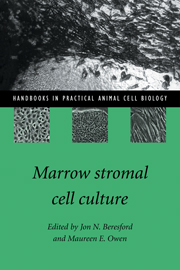Book contents
- Frontmatter
- Contents
- List of contributors
- Preface to the series
- Preface
- 1 The marrow stromal cell system
- 2 The bone marrow stroma in vivo: ontogeny, structure, cellular composition and changes in disease
- 3 Isolation, purification and in vitro manipulation of human bone marrow stromal precursor cells
- 4 Isolation and culture of human bone-derived cells
- 5 Marrow stromal adipocytes
- 6 Osteoblast lineage in experimental animals
- 7 Chondrocyte culture
- 8 Osteogenic potential of vascular pericytes
- Index
8 - Osteogenic potential of vascular pericytes
Published online by Cambridge University Press: 20 January 2010
- Frontmatter
- Contents
- List of contributors
- Preface to the series
- Preface
- 1 The marrow stromal cell system
- 2 The bone marrow stroma in vivo: ontogeny, structure, cellular composition and changes in disease
- 3 Isolation, purification and in vitro manipulation of human bone marrow stromal precursor cells
- 4 Isolation and culture of human bone-derived cells
- 5 Marrow stromal adipocytes
- 6 Osteoblast lineage in experimental animals
- 7 Chondrocyte culture
- 8 Osteogenic potential of vascular pericytes
- Index
Summary
Introduction
Pericytes in vivo
Pericytes are vascular cells identified in vivo by their anatomical location within the subendothelial basement membrane of blood vessels, in particular venules (sometimes called pericytic venules) and capillaries. Such vessels normally consist of three structural elements: (a) the basement membrane, a complex extracellular matrix synthesised by the vascular cells, (b) the endothelial cells, resting on the basement membrane and lining the lumen of the vessel, and (c) the pericytes, periendothelial cells embedded in the basement membrane, except at points of contact with the endothelium. Morphometric studies of skeletal muscle vasculature have indicated that pericytes are randomly positioned in capillaries and concentrated at endothelial cell junctions in venules (Sims, 1991). The ratio of endothelial cells to pericytes is highly variable, depending on species, age, type of vessel, tissue and pathological state (for reviews, see Sims, 1991; Shepro & Morel, 1993).
Pericytes have previously been described as adventitial, mural and Rouget cells. Other cells associated with vessel walls (e.g. smooth muscle cells, reticular cells in the bone marrow, mesangial cells in the kidney, stellate or Ito cells in the liver), cannot always be distinguished from pericytes, since specific markers for the different cell types have not been described. In vivo, pericytes are distinguished from endothelial cells mainly by their location, embedded within the basement membrane of vessel walls, and by the presence of von Willebrand Factor and Weibel Palade bodies in endothelial cells. However, this distinction is sometimes blurred, (pp. 129, 130, 134, 136–138).
- Type
- Chapter
- Information
- Marrow Stromal Cell Culture , pp. 128 - 148Publisher: Cambridge University PressPrint publication year: 1998
- 9
- Cited by



